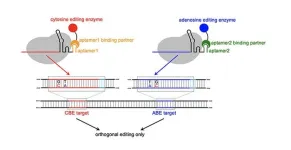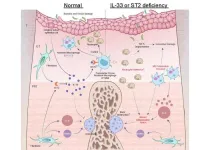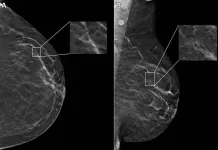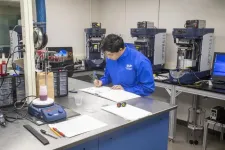(Press-News.org) Surgical teams at NYU Langone Health performed the world’s first genetically modified pig kidney transplants into a human body in September and November 2021, and then transplanted two pig hearts in the summer of 2022. These procedures were done in patients declared dead based on neurologic criteria (decedents) and maintained on ventilators with the consent of their families. Demonstrating the field’s progress, NYU Langone in April 2024 transplanted a pig kidney into a living patient.
Now two new analyses, one published online on May 17 in Nature Medicine and the other May 21 in Med, reveal changes at the single-cell level in the organs and recipient’s bodies before, during, and just after the xenotransplantation surgeries in the decedents. Teams of scientists had worked alongside the surgeons, taking blood and tissue samples to analyze changes in tens of thousands of collected cells.
Led by researchers at NYU Grossman School of Medicine and the Broad Institute of MIT and Harvard, the Med paper tracked the genetic and cellular activity in the two pig kidneys transplanted into humans, and compared them against pig kidney samples that had not been translated. To do so, the research team used several techniques, including single-cell RNA sequencing, which determined the order (sequence) of the molecular letters making up the pig and human genes active in various cell types during the procedures.
The study showed that the transplanted pig kidneys, while not rejected outright by the recipients’ bodies (no immediate kidney failure), caused a strong reaction in human peripheral blood mononuclear cells (PBMCs). This set of immune cells can attack transplanted (foreign) organs much like they attack foreign invaders (e.g. viruses). While immediate rejection was not seen, in part due to treatment with medications that suppressed it, the new study found evidence of subtler reactions that could cause xenotransplants to fail over time.
Specifically, the pig kidneys were seen to trigger “antibody-mediated rejection” at the molecular level. As the body develops immune proteins called antibodies specific to a transplanted organ, they recruit natural killer cells, macrophages, and T cells that can injure it. The team also saw an uptick in pig kidneys of tissue repair mechanisms, where certain cells multiply as part of the growth involved in healing. Normal cells that transform into cancer cells also grow aggressively, so the mechanism bears watching.
“We have detailed the cellular mechanisms that dictate how human immune cells react to a xenotransplant in the short term,” said Jef Boeke, PhD, a co-senior author on both studies, and director of the Institute for System Genetics at NYU Grossman School of Medicine. “These results give us new insights into how we might further engineer pig organs for transplant, or tailor immunosuppression treatments to improve tolerance of a foreign organ.”
By tracking the interplay between the kidneys and human system several times each day, the researchers found that pig kidney immune cells drove reactions right after the transplant, but that human immune cells infiltrated the pig organs by 48 hours to dominate signaling. Measuring the degree to which pig immune cells trigger the first wave of immune attack on xenotransplants will shape efforts to prevent irreversible cellular damage to them, say the study authors.
Transplanted Hearts
The other new paper, published in Nature Medicine, featured a “multiomics” analysis of pig hearts and surrounding human cells in decedents. This included analyses every six hours after transplant of gene activity (transcriptomics), as well of proteins (proteomics), lipids, and metabolites (intermediates in biological pathways) present in cells.
Rapid, massive increases in the number of certain cell types were also seen in decedents receiving pig hearts. In one of the decedents (D1) but not the other, activated T cell and natural killer (NK) cell populations within the PBMC group increased from about one percent 30 hours post-transplant to more than 20 percent of the entire PBMC population by 66 hours after the procedure. This dramatic immune reaction to the organ, a complication called perioperative cardiac xenograft dysfunction (PCXD), came with a damaging inrush of immune cells (inflammation), and misplaced healing attempts (tissue remodeling) that thicken tissue and can hinder function.
The worse outcomes experienced by the one decedent may be partly because this heart was smaller than anticipated for the recipient’s size, and required an extra procedure to compensate for it, the researchers said. These factors may have cut off blood flow and the oxygen supply to the heart for longer, which is known to cause ischemia reperfusion injury when the supply is restored. The research team observed that PCXD-related immune reactions to the pig organ got worse in the presence of this recipient’s reperfusion injury.
“This study demonstrated that multiomics can be used to reveal a broad picture of what is happening in the recipient of a xenograft,” said Brendan Keating, PhD, a co-senior author on both studies and faculty in Department of Surgery at NYU Grossman School of Medicine. “The team that did the xenotransplant had several theories about why the first decedent was having more issues, but multiomics helped to define the complications, and may be used to counter them moving forward.”
***
Robert Montgomery, MD, DPhil, the H. Leon Pachter chair of the Department of Surgery at NYU Langone Health was a co-senior author of the kidney paper. This study was also led by co-senior study author Bo Xia, PhD, a graduate student at the time of the study at NYU Grossman School of Medicine, who is now a principal investigator at the Broad Institute of MIT and Harvard. Co-first-authors were Wanqing Pan and Binghan Zheng of Dr. Xia’s group at the Broad Institute, and Weimin Zhang of the Institute for Systems Genetics (ISG) at NYU Grossman School of Medicine. Also a Broad Institute author was Jiangshan Bai. Other NYU Langone study authors were Brendan Camellato and Yinan Zhu at ISG; Jeffrey Stern, Elaina Weldon, Jacqueline Kim, Karen Khalil, Massimo Mangiola, and Adam Griesemer in the NYU Langone Transplant Institute; Adriana Heguy and Peter Meyn in the Genome Technology Center; Ziyan Lin and Alireza Khodadadi-Jamayran of the Applied Bioinformatics Laboratories, and Philip Sommer in the Department of Anesthesiology, Perioperative Care & Pain Medicine.
Along with Dr. Keating, a corresponding author of the Nature Medicine heart study, co-first authors were Eloi Schmauch and Dr. Xia, Brian Piening of the Providence Cancer Center in Portland, Maedeh Mohebnasab of the Division of the University of Pittsburgh Medical Center, Chenchen Zhu of Stanford University, Dr. Stern, and Weimin Zhang, of the ISG. Also NYU Langone authors were Jacqueline Kim, David Andrijevic, Karen Khalil, Ian Jaffe, Simon Williams, Elaina Weldon, Mercy Williams, Qian Guo, Sophie Widawsky, Vasishta Tatapudi, Massimo Mangiola, Navneet Narula, Nader Moazami, Harvey Pass, Adam Griesemer in the Transplant Institute; Brendan Camellato, Larisa Kagermazova, and Yinan Zhu in the ISG; Feng-Xia Liang, and Joseph Sall in Department of Cell Biology, Adriana Heguy in the Department of Pathology, and Han Chen and Ramin Herati in the Department of Medicine.
Additional authors were from the University of Pennsylvania, Stanford University, University of Oxford, Broad Institute, Imam Abdulrahman bin Faisal University in Saudi Arabia, the Paris Institute for Transplantation and Organ Regeneration, Cleveland Clinic, University of Eastern Finland, 10x Genomics, United Therapeutics (which provided funding), and Revivicor, Inc. All authors are listed in the study manuscript.
The authors would like to thank the families of the decedents for their generous donation to science, and LiveOnNY for providing end-of-life family support. The kidney work was supported in National Institute of Health grants RM1HG009491 and DP5OD033430. The heart work was supported by National Institute of Health grants R01 AI144522 and P30CA016087. Other funding sources of the heart study were the Orion Research Foundation, Yrjö Jahnsson Foundation; the Vilho, Yrjö and Väisälä Fund; Aarne Koskelon Foundation, and the Antti and Tyyne Soininen Foundation.
Dr. Boeke is a founder and consultant of CDI Labs, Inc., Neochromosome, Inc., and ReOpen Diagnostics. He serves or served on the scientific advisory boards of Logomix, Inc., Modern Meadow, Inc., Rome Therapeutics, Inc., Sample6, Inc., Sangamo, Inc., Tessera Therapeutics, Inc. and the Wyss Institute, all unrelated to the present work. Dr. Montgomery is on scientific advisory boards for eGenesis, Sanofi, Regeneron, CareDx and Hansa Biopharma, is a consultant to Recombinetics, and reports consulting fees from Hansa Medical, Regeneron, ThermoFisher Scientific, Genentech, CareDx, One Lambda, ITB Med, Sanofi and PPD Development, all unrelated to the present work. These relationships are being managed in keeping with the policies of NYU Langone Health.
END
Studies reveal cell-by-cell changes caused when pig hearts and kidneys are transplanted into humans
2024-05-21
ELSE PRESS RELEASES FROM THIS DATE:
SRI earns FDA Orphan Drug Designation for pancreatic cancer
2024-05-21
SRI’s Targeted Antigen Loaded Liposomes (TALL) — a treatment that expands the benefits of immunotherapy such as check-point inhibitors — has been granted Orphan Drug Designation (ODD) for pancreatic ductal adenocarcinoma (PDAC) by the U.S. Federal Drug Administration (FDA).
As a result, SRI’s future strategic partners can gain tax credits for qualified clinical trials and potentially receive market exclusivity for a period of seven years after the drug’s approval, among other benefits.
“FDA's orphan drug designation brings worthy attention to the demonstrated impact of SRI's TALL biotherapeutic for pancreatic cancer,” said Kathlynn Brown, ...
A new gene-editing system tackles complex diseases
2024-05-21
The human genome consists of around 3 billion base pairs and humans are all 99.6% identical in their genetic makeup. That small 0.4% accounts for any difference between one person and another. Specific combinations of mutations in those base pairs hold important clues about the causes of complex health issues, including heart disease and neurodegenerative diseases like schizophrenia.
Current methods to model or correct mutations in live cells are inefficient, especially when multiplexing — installing multiple point mutations simultaneously across the genome. Researchers from the University of California San Diego ...
Tracking down toxic metals from tobacco smoke
2024-05-21
Cigarette smoke has been studied for years, revealing a multitude of contaminants, including toxic metals. But exactly which of those metals can be traced to secondhand or thirdhand smoke? Solving this problem has been a challenge for the research community because many of the metals found in tobacco smoke could also come from industrial or naturally occurring pollutants contaminating indoor and outdoor air.
Now, a recent study by scientists at Lawrence Berkeley National Laboratory (Berkeley Lab) has identified 28 trace metals in tobacco smoke. The findings reported in the journal ...
Clarifying the cellular mechanisms underlying periodontitis with an improved animal model
2024-05-21
TMDU researchers have developed a technique that allows a detailed analysis of periodontitis development over time
Tokyo, Japan – Periodontal disease, represented by periodontitis, is the leading cause of tooth loss and affects close to one in five adults worldwide. In most cases, this condition occurs as a result of an inflammatory response to bacterial infection of the tissue around teeth. As the condition worsens, the gums begin to pull away, exposing teeth roots and bone. Notably, the incidence of periodontitis becomes more prevalent with age and with populations worldwide living ...
Age, race impact AI performance on digital mammograms
2024-05-21
OAK BROOK, Ill. – In a study of nearly 5,000 screening mammograms interpreted by an FDA-approved AI algorithm, patient characteristics such as race and age influenced false positive results. The study’s results were published today in Radiology, a journal of the Radiological Society of North America (RSNA).
“AI has become a resource for radiologists to improve their efficiency and accuracy in reading screening mammograms while mitigating reader burnout,” said Derek L. Nguyen, M.D., assistant professor at Duke University in Durham, North Carolina. ...
SwRI leads courses at 2024 Society of Tribologists & Lubrication Engineers Annual Meeting
2024-05-21
SAN ANTONIO — May 21, 2024 —As a leader in fuels and lubricants research, Southwest Research Institute is home to a world-class tribology laboratory and expert staff that are developing advanced techniques and technology to study wear, friction and lubrication. SwRI tribologists will share their expertise at the 2024 Society of Tribologists and Lubrication Engineers (STLE) Annual Meeting May 19-23 in Minneapolis.
The STLE Annual Meeting and Exhibition invites members of the lubricant industry ...
Hope for a cure for visceral leishmaniasis, an often fatal infectious disease
2024-05-21
Hope for a cure for visceral leishmaniasis, an often fatal infectious disease
A discovery by Simona Stäger’s team could help come up with a treatment to the most serious form of leishmaniasis.
Leishmaniasis is a tropical disease affecting a growing number of people worldwide. Each year, between 700,000 and 1 million new cases are reported. Caused by a protozoan parasite of the genus Leishmania, which is transmitted to humans by the simple bite of a sand fly, leishmaniasis comprises three clinical forms, of which the visceral ...
How AI helps programming a quantum computer
2024-05-21
Generative models like diffusion models are one of the most important recent developments in Machine Learning (ML), with models as Stable Diffusion and Dall.e revolutionizing the field of image generation. These models are able to produce high quality images based on some text description. “Our new model for programming quantum computers does the same but, instead of generating images, it generates quantum circuits based on the text description of the quantum operation to be performed”, explains Gorka Muñoz-Gil from the Department of Theoretical Physics of ...
New research reveals that prehistoric seafloor pockmarks off the California coast are maintained by powerful sediment flows
2024-05-21
New MBARI research on a field of pockmarks—large, circular depressions on the seafloor—offshore of Central California has revealed that powerful sediment flows, not methane gas eruptions, maintain these prehistoric formations. A team of researchers from MBARI, the United States Geological Survey (USGS), and Stanford University published their findings today in the Journal of Geophysical Research: Earth Surface. This work provides important information to guide decision-making about responsible use and management of the seafloor off California, including site assessments for the development of offshore wind farms.
The Sur Pockmark Field—an area about the size ...
AI can help improve ER admission decisions, Mount Sinai study finds
2024-05-21
New York, NY [May 21, 2024]—Generative artificial intelligence (AI), such as GPT-4, can help predict whether an emergency room patient needs to be admitted to the hospital even with only minimal training on a limited number of records, according to investigators at the Icahn School of Medicine at Mount Sinai. Details of the research were published in the May 21 online issue of the Journal of the American Medical Informatics Association (JAMIA/DOI: 10.1093/jamia/ocae103).
In the retrospective study, the researchers analyzed records from seven Mount Sinai Health System hospitals, using both structured data, such as vital signs, ...






